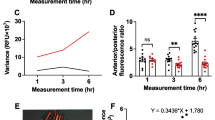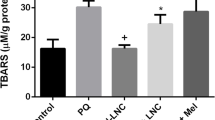Abstract
Methods for quantitative oral administration of various substances to Caenorhabditis elegans are needed. Previously, we succeeded in oral administration of hydrophilic substances using liposomes. However, an adequate system for delivery of hydrophobic chemicals was not available. In this study, we developed a method for oral administration of lipid-soluble substances to C. elegans. γ-cyclodextrin (γCD), which delivers hydrophobic chemicals, was used to make micro-particles of inclusion compounds that can be ingested by bacteriophagous nematodes, which do not distinguish these micro-particles from their food bacteria. Successful oral delivery of the hydrophobic fluorescent reagent 3,3′-dioctadecyloxacarbocyanine perchlorate into the intestines of C. elegans was observed. Oral administration of the hydrophobic antioxidants tocotrienol, astaxanthin, or γ-tocopherol, prolonged the nematode lifespan; tocotrienol rendered them resistant to infection with the opportunistic pathogen Legionella pneumophila. In contrast, older conventional delivery methods that involve incorporation of chemicals into the nematode growth medium or pouring chemicals onto the plate produced weaker fluorescence and no longevity effects. Our method efficiently and quantitatively delivers hydrophobic solutes to nematodes, and a minimum effective dose was estimated. In combination with our liposome method, this γCD method expands the usefulness of C. elegans for the discovery of functional food factors and for screening drug candidates.





Similar content being viewed by others
References
Adachi H, Ishii N (2000) Effects of tocotrienols on life span and protein carbonylation in Caenorhabditis elegans. J Gerontol A Biol Sci Med Sci 55:B280–B285
Bass TM, Weinkove D, Houthoofd K, Gems D, Partridge L (2007) Effects of resveratrol on lifespan in Drosophila melanogaster and Caenorhabditis elegans. Mech Ageing Dev 128:546–552
Bhagavan HN, Chopra RK, Craft NE, Chitchumroonchokchai C, Failla ML (2007) Assessment of coenzyme Q10 absorption using an in vitro digestion-Caco-2 cell model. Int J Pharm 333:112–117
Braeckman BP, Houthoofd K, Brys K, Lenaerts I, De Vreese A, Van Eygen S, Raes H, Vanfleteren JR (2002) No reduction of energy metabolism in Clk mutants. Mech Ageing Dev 123:1447–1456
Brown MK, Evans JL, Luo Y (2006) Beneficial effects of natural antioxidants EGCG and alpha lipoic acid on life span and age-dependent behavioral declines in Caenorhabditis elegans. Pharmacol Biochem Behav 85:620–628
Gerstbrein B, Stamatas G, Kollias N, Driscoll M (2005) In vivo spectrofluorimetry reveals endogenous biomarkers that report healthspan and dietary restriction in Caenorhabditis elegans. Aging Cell 4:127–137
Goldstein P, McCann-Hargrove E, Magnano L (1993) Hypervitaminosis E and gametogenesis in Caenorhabditis elegans. Cytobios 73:121–133
Gruber J, Tang SY, Halliwell B (2007) Evidence for a trade-off between survival and fitness caused by resveratrol treatment of Caenorhabditis elegans. Ann N Y Acad Sci 1100:530–542
Hoshino K, Yasui C, Ikeda T, Arikawa K, Toshima H, Nishikawa Y (2008) Evaluation of Caenorhabditis elegans as the host in an infection model for food-borne pathogens. Jpn J Food Microbiol 25:137–147
Ikeda T, Yasui C, Hoshino K, Arikawa K, Nishikawa Y (2007) Influence of lactic acid bacteria on longevity of Caenorhabditis elegans and host defense against Salmonella entetica serovar Enteritidis. Appl Environ Microbiol 73:6404–6409
Ishii N, Senoo-Matsuda N, Miyake K, Yasuda K, Ishii T, Hartman PS, Furukawa S (2004) Coenzyme Q10 can prolong C. elegans lifespan by lowering oxidative stress. Mech Ageing Dev 125:41–46
Kampkötter A, Gombitang Nkwonkam C, Zurawski RF, Timpel C, Chovolou Y, Watjen W, Kahl R (2007) Effects of the flavonoids kaempferol and fisetin on thermotolerance, oxidative stress and FoxO transcription factor DAF-16 in the model organism Caenorhabditis elegans. Arch Toxicol 81:849–858
Kampkötter A, Timpel C, Zurawski RF, Ruhl S, Chovolou Y, Proksch P, Watjen W (2008) Increase of stress resistance and lifespan of Caenorhabditis elegans by quercetin. Comp Biochem Physiol B Biochem Mol Biol 149:314–323
Keaney M, Matthijssens F, Sharpe M, Vanfleteren J, Gems D (2004) Superoxide dismutase mimetics elevate superoxide dismutase activity in vivo but do not retard aging in the nematode Caenorhabditis elegans. Free Radic Biol Med 37:239–250
Klass MR (1977) Aging in the nematode Caenorhabditis elegans: major biological and environmental factors influencing life span. Mech Ageing Dev 6:413–429
Komura T, Yasui C, Miyamoto H, Nishikawa Y (2010) Caenorhabditis elegans as an alternative model host for Legionella pneumophila and the protective effects of Bifidobacterium infantis. Appl Environ Microbiol 76:4105–4108
Larsen PL, Clarke CF (2002) Extension of life-span in Caenorhabditis elegans by a diet lacking coenzyme Q. Science 295:120–123
Melov S, Ravenscroft J, Malik S, Gill MS, Walker DW, Clayton PE, Wallace DC, Malfroy B, Doctrow SR, Lithgow GJ (2000) Extension of life-span with superoxide dismutase/catalase mimetics. Science 289:1567–1569
Mohri-Shiomi A, Garsin DA (2008) Insulin signaling and the heat shock response modulate protein homeostasis in the Caenorhabditis elegans intestine during infection. J Biol Chem 283:194–201
Pun PB, Gruber J, Tang SY, Schaffer S, Ong RL, Fong S, Ng LF, Cheah I, Halliwell B (2010) Ageing in nematodes: do antioxidants extend lifespan in Caenorhabditis elegans? Biogerontology 11:17–30
Shibamura A, Ikeda T, Nishikawa Y (2009) A method for oral administration of hydrophilic substances to Caenorhabditis elegans: effects of oral supplementation with antioxidants on the nematode lifespan. Mech Ageing Dev 130:652–655
Srivastava D, Arya U, SoundaraRajan T, Dwivedi H, Kumar S, Subramaniam JR (2008) Reserpine can confer stress tolerance and lifespan extension in the nematode C. elegans. Biogerontology 9:309–316
Stiernagle T (1999) Maintenance of C. elegans. In: Hope IA (ed) C. elegans: a practical approach. Oxford University Press, New York, pp 51–67
Wilson MA, Shukitt-Hale B, Kalt W, Ingram DK, Joseph JA, Wolkow CA (2006) Blueberry polyphenols increase lifespan and thermotolerance in Caenorhabditis elegans. Aging Cell 5:59–68
Wu Z, Smith JV, Paramasivam V, Butko P, Khan I, Cypser JR, Luo Y (2002) Ginkgo biloba extract EGb 761 increases stress resistance and extends life span of Caenorhabditis elegans. Cell Mol Biol 48:725–731
Wu D, Rea SL, Yashin AI, Johnson TE (2006) Visualizing hidden heterogeneity in isogenic populations of C. elegans. Exp Gerontol 41:261–270
Yazaki K, Yoshikoshi C, Oshiro S, Yanase S (2011) Supplemental cellular protection by a carotenoid extends lifespan via Ins/IGF-1 signaling in Caenorhabditis elegans. Oxid Med Cell Longev 2011:596240
Zou SG, Sinclair J, Wilson MA, Carey JR, Liedo P, Oropeza A, Kalra A, de Cabo R, Ingram DK, Longo DL, Wolkow CA (2007) Comparative approaches to facilitate the discovery of prolongevity interventions: effects of tocopherols on lifespan of three invertebrate species. Mech Ageing Dev 128:222–226
Acknowledgments
This study was supported by a Grant-in-aid for Scientific Research C (No. 23617017) from the Ministry of Education, Culture, Sports, Science and Technology of Japan, and a Grant of the Osaka City University Graduate School of Human Life Science in 2009 and 2010. The nematodes used in this study were kindly provided by the Caenorhabditis Genetics Center, which is funded by the NIH National Center for Research Resources (NCRR).
Author information
Authors and Affiliations
Corresponding author
Electronic supplementary material
Below is the link to the electronic supplementary material.
Rights and permissions
About this article
Cite this article
Kashima, N., Fujikura, Y., Komura, T. et al. Development of a method for oral administration of hydrophobic substances to Caenorhabditis elegans: pro-longevity effects of oral supplementation with lipid-soluble antioxidants. Biogerontology 13, 337–344 (2012). https://doi.org/10.1007/s10522-012-9378-3
Received:
Accepted:
Published:
Issue Date:
DOI: https://doi.org/10.1007/s10522-012-9378-3




